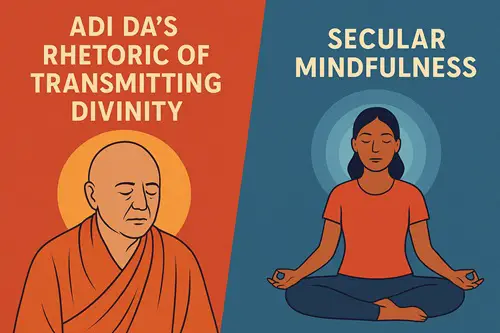|
TRANSLATE THIS ARTICLE
Integral World: Exploring Theories of Everything
An independent forum for a critical discussion of the integral philosophy of Ken Wilber
  Frank Visser, graduated as a psychologist of culture and religion, founded IntegralWorld in 1997. He worked as production manager for various publishing houses and as service manager for various internet companies and lives in Amsterdam. Books: Ken Wilber: Thought as Passion (SUNY, 2003), and The Corona Conspiracy: Combatting Disinformation about the Coronavirus (Kindle, 2020). Frank Visser, graduated as a psychologist of culture and religion, founded IntegralWorld in 1997. He worked as production manager for various publishing houses and as service manager for various internet companies and lives in Amsterdam. Books: Ken Wilber: Thought as Passion (SUNY, 2003), and The Corona Conspiracy: Combatting Disinformation about the Coronavirus (Kindle, 2020).
Check out my other conversations with ChatGPT
THOUGHTS ON ADI DA SAMRAJ
The Legacy of Adi Da Samraj The Myth of Uniqueness Two Models of Inner Transformation Beyond Lineage, Beyond Comparison Narrative Control in Adi Da's Writings Two Models of Inner TransformationAdi Da's Rhetoric of Transmitted Divinity Versus Secular MindfulnessFrank Visser / ChatGPT

1. Introduction: Two Visions of Inner LifeAdi Da Samraj proclaimed himself the “seventh-stage Adept” who embodied the “Divine Condition”—a state not merely realized but radiantly present in his person. According to his teaching, one could awaken to this ultimate reality only through surrender to his agency, receiving his spiritual transmission or “Grace.” In stark contrast stands the modern secular mindfulness movement, which frames contemplative practice not as a mystical transaction but as a trainable skill producing measurable benefits for body, mind, and sense of self. This essay contrasts these two paradigms—one metaphysical, one empirical—and shows how their underlying assumptions shape the experience and interpretation of inner life. 2. Adi Da's Core Claim: Consciousness Is the Divine ConditionAdi Da's central rhetorical move is to collapse the distinction between one's own awareness and the transcendent Godhead. This was not presented as a metaphysical conjecture but as an ontological fact accessible by grace:
This rhetorical architecture has three implications:
3. Body, Mind, Self in Adi Da's Model
Thus, body, mind, and self are not independent spheres to train but obstacles to transcend. The framework emphasizes grace over agency, transmission over training. 4. Secular Mindfulness: A Counter-ModelBy contrast, secular mindfulness (e.g., MBSR, MBCT, and meditation research) adopts a radically different stance:
Let's examine each level. 4.1 Body: Physiological RegulationMindfulness reduces stress, lowers blood pressure, improves immune function, and increases heart-rate variability. These are observable effects tied to practice time and not contingent on surrender to an enlightened figure. 4.2 Mind: Cognitive Flexibility and Emotion RegulationMindfulness increases attentional control, reduces rumination, and enhances emotional balance. Participants learn to observe thoughts without identification, achieving many of the benefits Adi Da attributed to “ego-transcendence,” but without metaphysical claims. 4.3 Self: Decentering and Self-CompassionSecular mindfulness fosters a gradual loosening of rigid self-concepts—a “soft” form of ego transcendence. Instead of being told “you are already the Divine Condition,” practitioners observe how the sense of self arises and dissolves moment to moment. This decentering echoes classic Buddhist insight but remains agnostic about metaphysics. 5. Two Epistemologies, Two Outcomes
6. The Problem of “Transmitted Realization”The claim that a guru can transmit enlightenment is not only unfalsifiable but also creates a power asymmetry. It fosters dependency and discourages the kind of skeptical inquiry that drives secular mindfulness research. Without independent evidence, transmission remains a belief system, not a verified phenomenon. 7. The Appeal of Grace Versus the Work of PracticeWhy does Adi Da's message appeal despite its implausibility? Because it promises an instant shortcut—the dissolution of suffering by proximity to a perfected being. Secular mindfulness demands sustained effort and offers only gradual, probabilistic benefits. The former resembles religious salvation; the latter resembles psychological training. Sidebar: From Grace to Practice — Adi Da versus Wilber's Integral Life PracticeAdi Da's “Grace Model.”
Wilber's “Integral Life Practice” (ILP).
ImplicationsWilber's shift to ILP can be read as a tacit retreat from his earlier endorsement of guru-centered spirituality. Instead of locating the ultimate catalyst in a single Adept, ILP disperses agency back to the practitioner. This democratizes spiritual development and places it on a continuum with secular self-improvement, closing the gap between mystical aspiration and empirical psychology. TakeawayWhere Adi Da concentrated authority and promised metaphysical transformation by grace, Wilber's ILP reflects a post-guru paradigm: practice-based, modular, and user-directed. The contrast underscores how even within the “integral” movement, the locus of power has shifted from charismatic transmission to participatory cultivation. 8. Conclusion: From Rhetoric to RealityAdi Da's rhetoric of seeing one's own consciousness as the Divine Condition and accessing it through his grace exemplifies a metaphysical monopoly on awakening. In contrast, secular mindfulness treats the same human capacities—attention, awareness, and self-reflection—as trainable skills embedded in the nervous system and social context. The first model centralizes the guru; the second democratizes contemplative practice. Ultimately, the contrast reveals not just two different practices but two different ways of knowing: faith in transmission versus evidence-based cultivation. If Adi Da represents the apex of modern guru mystique, secular mindfulness represents the slow but steady deconstruction of that mystique into open-source human potential.
Comment Form is loading comments...
|